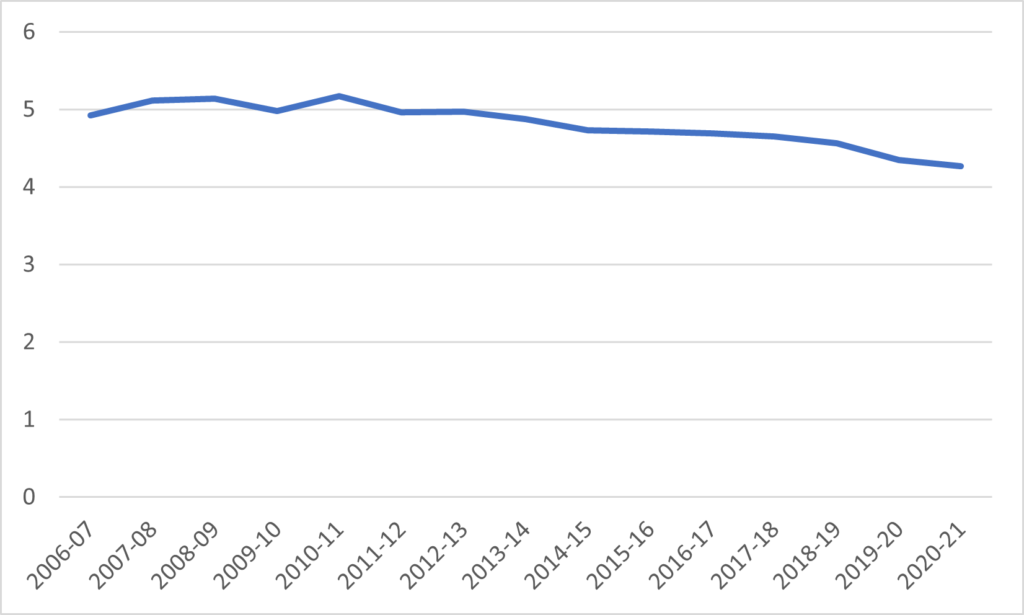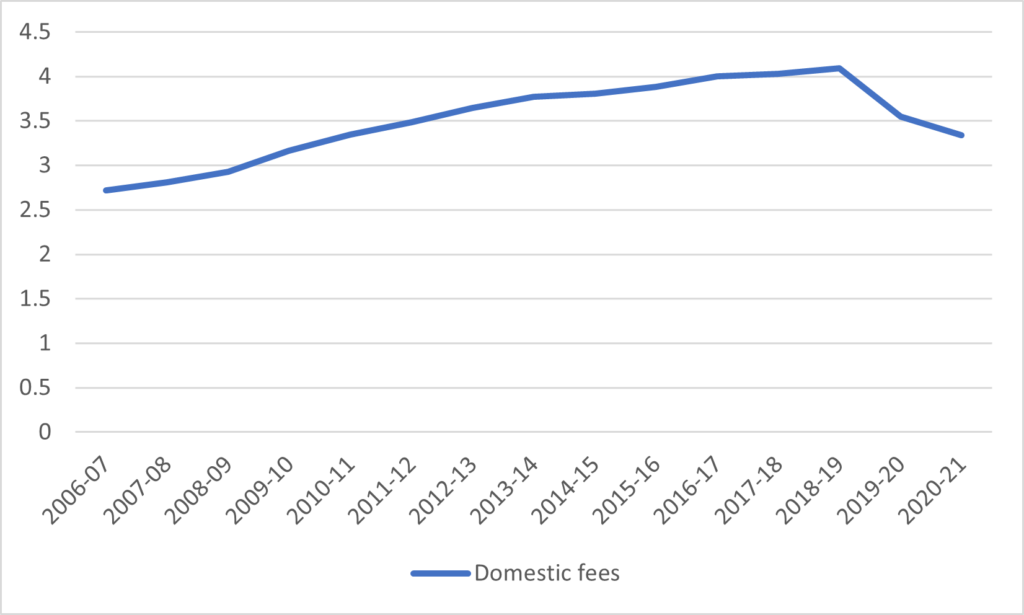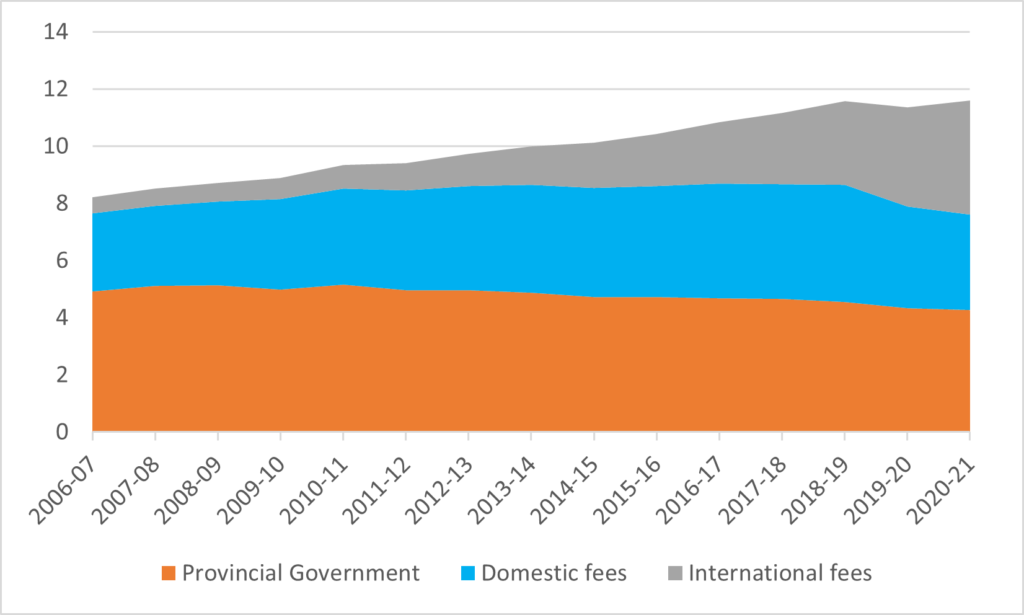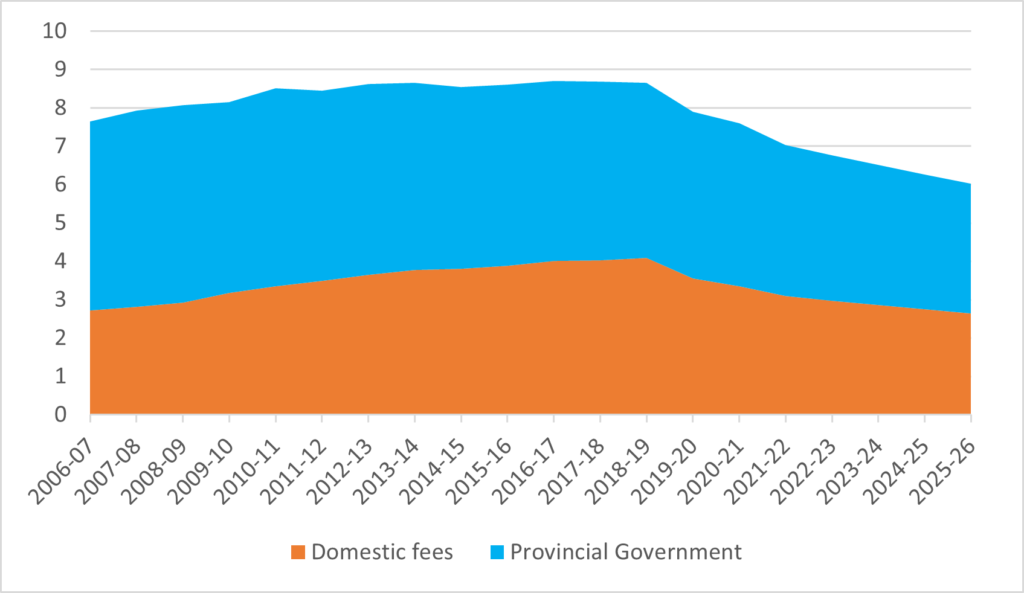I am going to make two controversial claims. The first is that the Ford government probably gets too much stick for its performance on higher education in its first term, and the second is that Ford’s second term looks set to be a LOT worse than the first.
Ready? Here we go.
The current Ford government in Ontario is often accused of “slashing funding” to universities. However, as far as direct funding to institutions is concerned, the Ford government is effectively no different from the Wynne government it replaced: transfers have stayed constant in nominal dollars and declined in real ones.
Figure 1: Provincial Government Transfers to Universities, Ontario, 2006-07 to 2020-21, in billions of $2020.

The biggest difference between the Wynne and the first Ford government was not in institutional funding but rather in tuition and student assistance. The Ford government (justly) gets a lot of flak for the hatchet job it did on the province’s student aid program, but people are quieter about his other signature policy – a 10% tuition cut followed by what is now four years of frozen domestic tuition. The silence is because the academic and student left has been asking for lower fees for years and are deeply embarrassed by who delivered it: but one major consequence of the silence is that people have no real understanding of what this cut and freeze are doing to university finances. Just between 2018-19 and 2020-21 – that is, before the really nasty bout of inflation started – real fee revenue from domestic sources appears to have dropped by about $800 million or 18%.
Figure 2: Estimated Aggregate Domestic Tuition Fees, Ontario, 2006-07 to 2020-21, in billions of $2020.

So, cuts to institutional funding and cuts to tuition: that means declining university budgets, right? Well, no. As I have noted, institutions always have the option to make up the cash through international student fees. By my calculations, fees from international students rose eightfold between 2006-07 and 2020-21 at Ontario universities. Aggregate international fee revenue passed fees from domestic students as a source of institutional revenue in Ontario in 2020-21, and probably passed provincial government transfers last year.
Figure 3: Major Sources of University Revenue, Ontario, 2006-07 to 2020-21, in billions of $2020.

So far, so boring. Usher bangs on about all this stuff all the time: what’s new here? Well, the answer is simply that all the data we have looked at to date only gets us halfway into the Ford administration. What’s starting to look terrifying is the possibility of the government continuing its policies through a second term combined with the effect of inflation, which I suspect will stay elevated – relative to pre-COVID levels – for some time.
Just in this year alone, flat nominal transfers plus flat tuition revenue looks set to cost the sector about half a billion dollars after inflation is considered. In Figure 4, I extend the analysis to the end of the Ford government’s second term, assuming i) that it persists in its position of maintaining the tuition freeze, ii) that it continues to fund institutions at the same level in nominal dollars as it currently does and iii) that inflation from 2023 onwards is 4%. It’s…well, a disaster. For these two categories, the so-called “government-controlled” revenue sector, the projection is that university funding in 2025-26 will be over $2.5 billion below where it was in 2018, or a drop of about 30% in real dollars.
Figure 4: Projected University Revenue from Government-Controlled Sources, Ontario, 2006-07 to 2025-26, in billions of $2020.

Now, again, this doesn’t necessarily mean that institutions will see cuts. They can always turn, as they have done in the past and as the college sector has done in spades over the last few years – to international students. But making up this kind of gap won’t be easy. It will require that international student fees – already the highest in the country by some distance – continue to increase ahead of inflation, and it requires about a 25% increase in international student numbers. And that’s just to make up for ebbing publicly-controlled funding: if anyone wants a raise or anything, that’s extra.
What are the odds that this will come to pass? Underfunding institutions is, as we have seen, a bipartisan affair in Ontario, so my guess is that any increases in funding will be well below inflation. And as for the prospect of tuition rises: it’s hard to say. I can see one scenario in which the Conservatives stick with them for another four years, and another where they decide to allow fees to rise in order to relieve the pressure on institutions, so it’s hard to say. Of course, the Ford government could surprise us all and change policy on either fees or transfers. Certainly, the inflation/growth boost putting the wind in many provinces’ fiscal sails gives the government far more room for fiscal experimentation than anyone thought possible this time two years ago.
Things could change. All I’m saying here is that if they don’t, the system is in for one heck of a ride over the next three years.

 Tweet this post
Tweet this post

That’s because the most vocal and prolific voters are seniors and they mostly only care about health care and and other programs that benefit them most. University funding (despite the fact that that’s where the majority of health care advances come from) is not on their radar. Youth, for whom this is more of an issue, are a smaller cohort and don’t vote in large numbers.
Interesting analysis. If they’re going to increase tuition fees they do need to bring back the student grant program and do way more to subsidise Ontario students university education. We have the lowest share of public funding for universities in the entire country, and less well of students shouldn’t be punished.